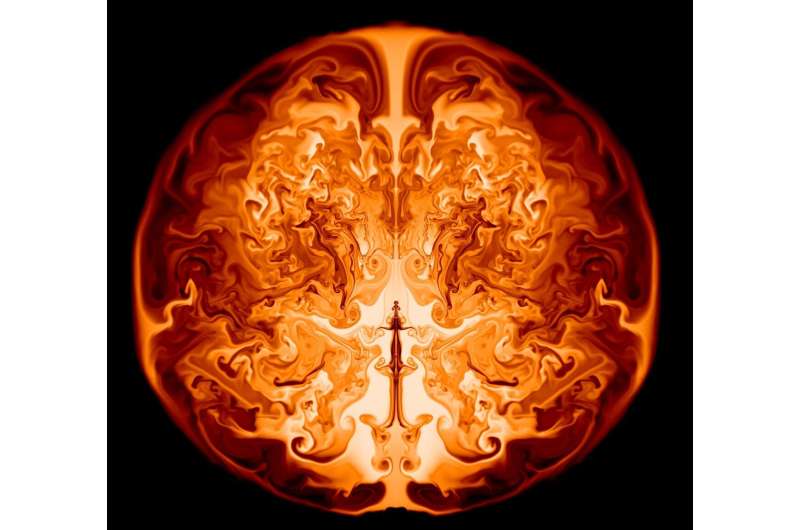A mirrored half-slice through the interior of a simulated exploding supermassive star of 55,500 solar masses one day after the onset of the explosion. The radius of outer circumference is close to the Earth’s orbit. Credit: K.-J. Chen
Recent observations have shown that there is a supermassive black hole at the center of each galaxy. However, what is the origin of these supermassive black holes? It is still a mystery today. An international research team led by the National Astronomical Observatory of Japan and Academia Sinica Institute of Astronomy and Astrophysics (ASIAA) in Taiwan has predicted an extreme supernova from a supermassive star, possible the progenitor of supermassive black holes. Their calculation suggested that this supernova can be observed by the James Webb Space Telescope (JWST) that will be launched by the end of 2021.
Studying the formation of supermassive black holes is a significant topic in modern astrophysics. The leading theory suggests the seeds of supermassive black holes formed after the death of the first massive stars in the early universe, and then these seeds continued to accumulate the surrounding gas and finally formed into supermassive black holes today. However, this theory was challenged because the most massive stars observed in the local universe are about one or two hundred solar masses. If the first stars with a few hundred solar masses die as black hole seeds, which need to maintain the highest accretion efficiency to form the supermassive black holes observed today. But it is very difficult to maintain a high accretion rate in a realistic environment.
Assistant Research Fellow, Ke-Jung Chen from ASIAA Taiwan proposed a relativistic instability supernova from a primordial supermassive star (104–105 solar masses) in his 2014 research paper. "There may be a small number of the first stars in the early universe with tens of thousands of solar masses. They are likely to be the progenitors of supermassive black holes in galaxies. Because the more massive of the black hole seed, the more efficient it is to swallow the surrounding matter. The black holes don't need to maintain a high accretion rate to grow quickly," said Chen.
But how to prove these massive stars once existed? This is an observational challenge, because most of these supermassive stars are to collapse into black holes. Based on the supernova model proposed by Chen, the research team performed a new radiation transport simulation and found that the upcoming JWST mission has a chance to observe this supernova! If it is actually observed by then, the origin of the supermassive black hole in the galaxy that comes from the first supermassive star can be confirmed. Let's wait and see!
More information: Takashi J Moriya et al. Observational properties of a general relativistic instability supernova from a primordial supermassive star, Monthly Notices of the Royal Astronomical Society (2021). DOI: 10.1093/mnras/stab622
Journal information: Monthly Notices of the Royal Astronomical Society
Provided by ASIAA
























